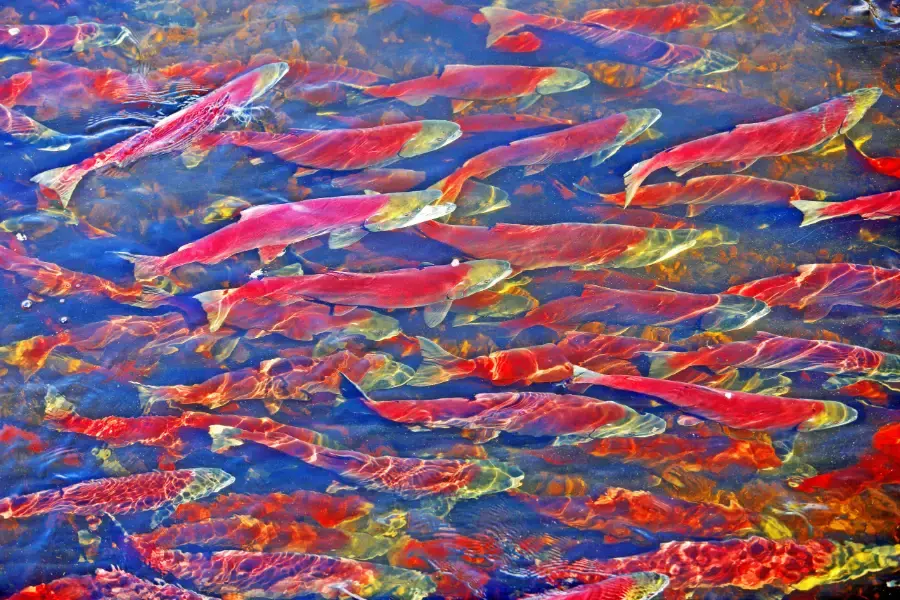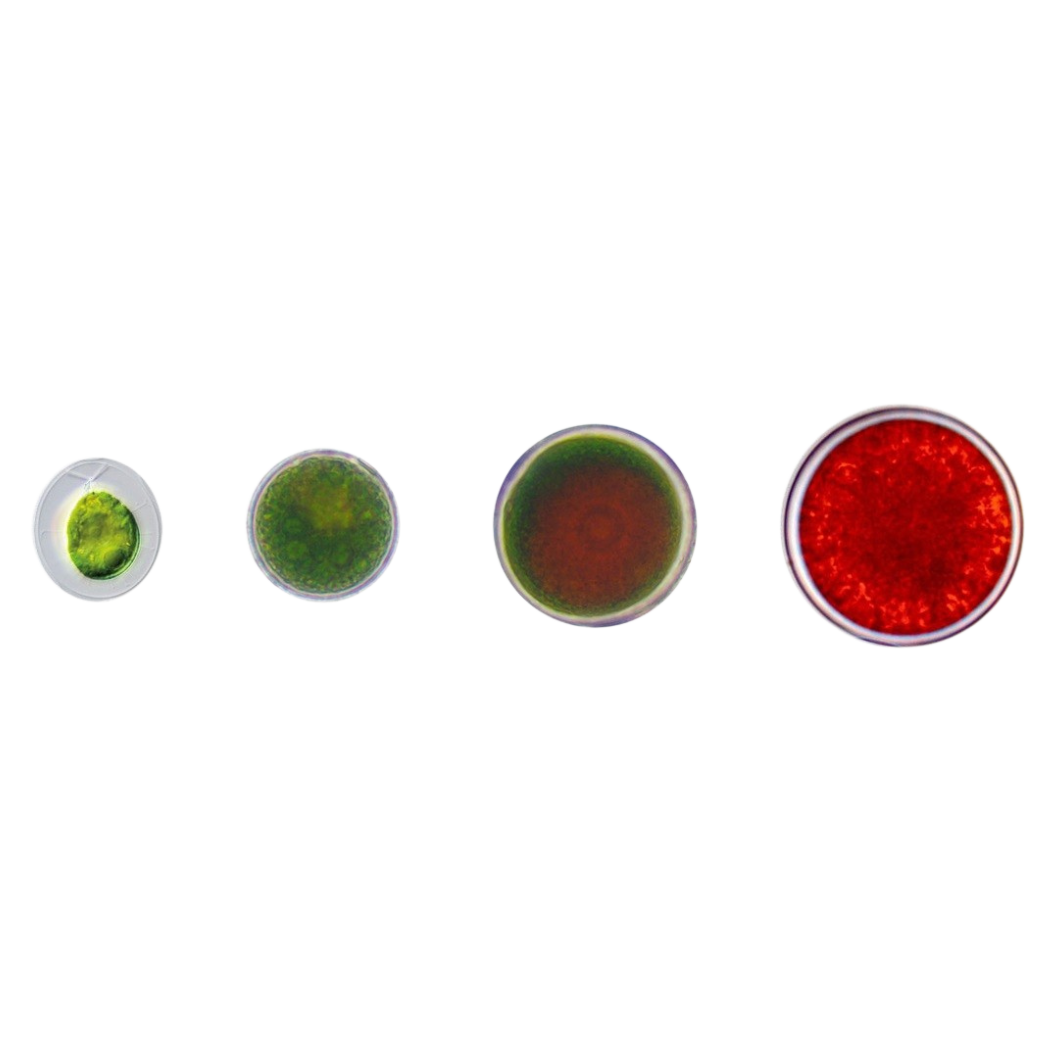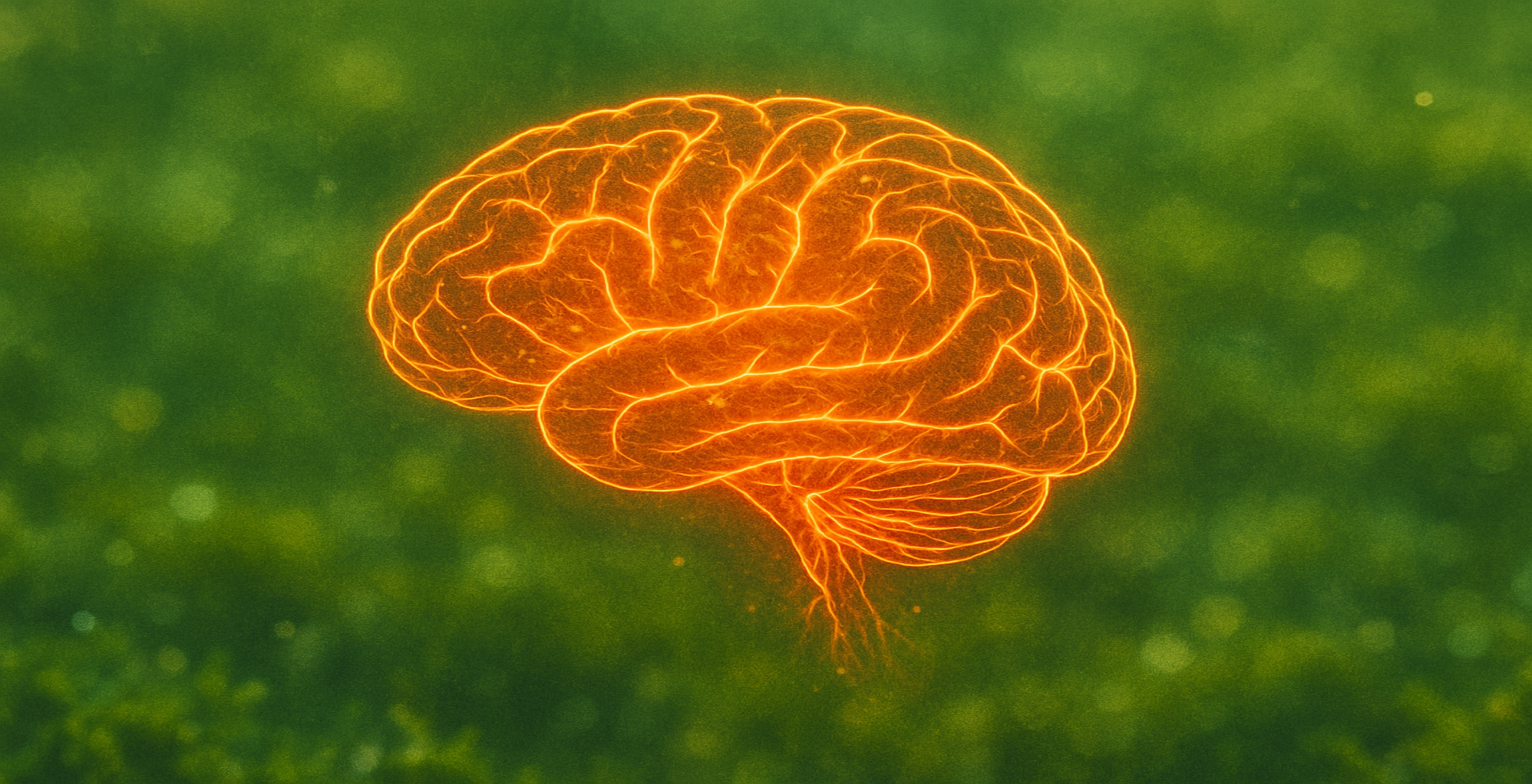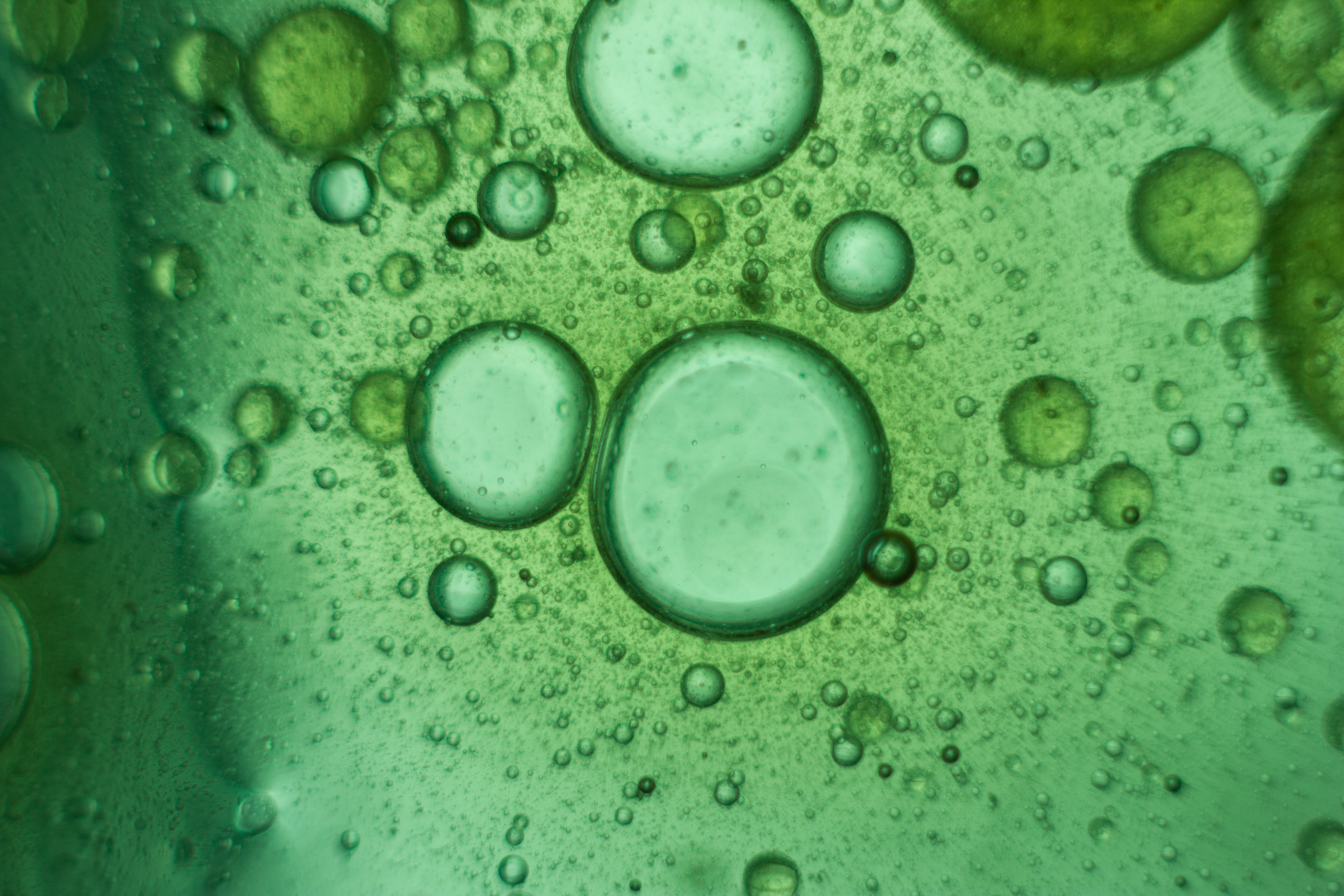Table of contents

Maarten Muys
Dr. ir. Maarten Muys holds a masters degree in Environmental Technology and a PhD in Bioengineering. He specialized in sustainable microbial protein production and microalgae cultivation. Maarten has amassed over 12 years of experience in algae cultivation and has published numerous paper on the topic.
The 10 Best Astaxanthin-Rich Foods You Should Be Eating
Looking to supercharge your diet with one of nature's most powerful antioxidants? You might already be taking vitamin C and eating berries for their antioxidant properties, but there's a lesser-known superstar you should add to your nutritional lineup: natural astaxanthin.
This vibrant red compound, known as astaxanthin, is responsible for the distinct pink-red color of salmon and other marine life. While it doesn't get nearly as much attention as other antioxidants, scientific research shows it's up to 6,000 times more powerful than vitamin C and 550 times stronger than vitamin E when it comes to fighting free radicals.1
But did you know there’s a major difference between natural and synthetic astaxanthin in terms of quality and bioavailability2? Read more here: Natural vs. Synthetic Astaxanthin – What You Need to Know.
I've done the research and compiled the 10 best food sources of this powerhouse nutrient. Let's dive in and discover how you can naturally boost your astaxanthin intake!
What Is Astaxanthin and Why Should You Care?
Before we jump into the food list, let's get one thing straight: astaxanthin (pronounced asta-ZAN-thin) isn't just another obscure nutrient.
Natural astaxanthin is a potent carotenoid antioxidant, often compared to beta-carotene and lycopene. But what makes it unique is its ability to protect cells from oxidative stress at an unmatched level.3
We dive into why astaxanthin outperforms other antioxidants here: Astaxanthin – The Extraordinary Antioxidant.
On top, is its unique molecular structure (C40H52O4) that contains both hydroxyl and ketone groups. This structure allows it to protect both the inner and outer layers of your cell membranes4—something most other antioxidants can't do. This "membrane-spanning" ability means it provides comprehensive protection throughout your cells.5
The benefits? They're impressive and backed by solid research:
- Supports heart health and healthy blood lipid levels
- Promotes skin health and protects against UV damage
- Enhances eye health and reduces eye fatigue
- Supports brain function and cognitive performance
- Aids exercise recovery and reduces muscle soreness
- Promotes a healthy inflammatory response
Now that you know why you should be getting more of this nutrient, let's look at the top food sources.
The 10 Best Sources of Astaxanthin in Food
1. Wild Sockeye Salmon
Astaxanthin content: 26-38 mg per kg flesh⁶
If you're looking for the king of astaxanthin-rich foods, wild sockeye salmon wears the crown. With its deep red-orange flesh, this fish contains significantly more astaxanthin than its farm-raised counterparts. According to research published in Marine Drugs, sockeye salmon contains between 26-38 mg of astaxanthin per kg of flesh, which is the highest among wild salmonids.⁶
Why the difference? The reason wild salmon is so rich in astaxanthin is that it feeds naturally on Haematococcus pluvialis microalgae, the primary source of natural astaxanthin. Unfortunately, farmed salmon is often fed synthetic alternatives, which are less bioavailable and less beneficial. Learn why in this article: Natural vs. Synthetic Astaxanthin
Important to keep in mind: for the most benefits, opt for wild-caught whenever possible.

How to enjoy it?
Grill with a simple lemon-herb marinade or bake it with a maple glaze. Even canned wild sockeye salmon contains decent amounts, making it a budget-friendly option.
2. Rainbow Trout
Astaxanthin content: 24 mg per kg flesh (wild), 12-25 mg per kg flesh (farmed)⁶
Similar to salmon but typically more affordable, rainbow trout is another excellent source of astaxanthin. The flesh has that distinctive pinkish-orange hue that signals the presence of this powerful antioxidant. Research shows that wild rainbow trout can contain up to 24 mg of astaxanthin per kg of flesh, while farmed varieties contain 12-25 mg per kg.⁶

How to enjoy it?
Trout has a delicate, mild flavor that pairs wonderfully with almonds and lemon. Try it pan-seared with a little butter and herbs for a quick weeknight dinner that delivers both flavor and nutrition.
3. Coho Salmon
Astaxanthin content: 10-21 mg per kg flesh⁶
Also known as silver salmon, coho salmon is another excellent source of astaxanthin with content ranging from 10-21 mg per kg of flesh.⁶ This makes it the second-richest wild salmon source of this powerful antioxidant.

How to enjoy it?
Coho salmon has a moderate flavor and firm texture that holds up well to grilling, broiling, or baking. Try it with a honey-mustard glaze or simple herbs and lemon.
4. Shrimp
Astaxanthin content: 147.7 mg per kg⁷
Shrimp are an impressive source of astaxanthin, containing approximately 147.7 mg per kg.⁷ Interestingly, the astaxanthin in shrimp exists in different forms: 3.95% free form, 74.29% diester form, and 19.72% monoester form.⁷ The distribution varies by body part, with higher concentrations in the head (25.81 to 124.47 μg/g) and carapace (45.57 to 75.08 μg/g) than in the meat (7.42 to 14.01 μg/g).⁹
How to enjoy them?
Shrimp scampi, gumbo, or a classic shrimp boil are all fantastic ways to incorporate these astaxanthin sources into your diet. Just remember that the cooking method can affect retention—gentle methods like steaming may preserve more nutrients.

5. Crayfish
Astaxanthin content: 153 mg per kg⁸
Also called crawfish or crawdads, crayfish contain an impressive 153 mg of astaxanthin per kg, including 40.3% in free form and 49.4% in ester form.⁸ This makes crayfish one of the richest crustacean sources of astaxanthin.

How to enjoy it?
A Southern cooking favorite, crayfish is often enjoyed boiled with cajun spices, added to gumbo, or featured in crawfish étouffée.
6. Snow Crab
Astaxanthin content: 119.6 mg per kg⁷
Snow crab contains approximately 119.6 mg of astaxanthin per kg, with 21.16% in free form, 5.11% in monoester form, and 56.57% in diester form.⁷ This makes it another excellent crustacean source of this powerful antioxidant.

How to enjoy it?
Snow crab legs are delicious simply steamed and served with melted butter. The sweet, delicate meat is a delicacy that also happens to provide significant astaxanthin.
7. Atlantic Salmon
Astaxanthin content: 3-10 mg per kg flesh (wild), 1-9 mg per kg flesh (farmed)⁶
Atlantic salmon contains less astaxanthin than sockeye but is still a good source, with wild varieties providing 3-10 mg per kg and farmed varieties offering 1-9 mg per kg.⁶ While not as rich as sockeye, Atlantic salmon is more widely available and still provides meaningful amounts of this antioxidant.

How to enjoy it?
Atlantic salmon works well with nearly any cooking method—grill, bake, pan-sear, or poach. Its milder flavor makes it versatile for various cuisine styles.
8. Lobster
Astaxanthin content: 54 mg per kg (dry weight basis)10
Lobster waste (including the head, hard carapace, viscera, mandibles, and gills) contains approximately 54 μg of total astaxanthin per gram on a dry weight basis. When processed into a carotenoprotein complex powder, the concentration can increase to 295 μg per gram.

How to enjoy it?
Lobster thermidor, steamed with butter, or in a luxurious lobster roll—all are excellent ways to enjoy this seafood delicacy.
9. Tiger Prawn
Astaxanthin content: 132,79 (± 1.5 mg) per kg11
Tiger prawns contain substantial amounts of astaxanthin (132,79 ± 1.5 mg per kg), making them another excellent crustacean source of this antioxidant.7
How to enjoy them?
Tiger prawns are delicious grilled, in curries, stir-fries, or simply prepared with garlic and butter. Their size and sweet flavor make them a special treat.

10. Sea Urchin Eggs
Astaxanthin content: 27 per mg, 27.000mg per kg 12
Farmed sea urchin (Arbacia lixula) eggs contain a surprisingly high concentration of astaxanthin (± 27± 7.5 μg per mg), making them one of the most concentrated sources of this antioxidant as it provided 27.000mg of astaxanthin per kg.
How to enjoy them?
Sea urchin eggs, also known as uni, are considered a delicacy in many cuisines, particularly Japanese. They're often enjoyed as sushi or added to pasta dishes for their rich, buttery flavor.

Haematococcus pluvialis: The Ultimate Source of Astaxanthin
While seafood like shrimp and wild salmon are excellent dietary sources of astaxanthin, they pale in comparison to Haematococcus pluvialis, a freshwater microalgae that naturally accumulates the highest levels of this powerful antioxidant.
Under optimal conditions, H. pluvialis can contain up to 40 mg of astaxanthin per gram of dry weight—which translates to an astonishing 40,000 mg per kg1.
This is over 270 times more astaxanthin than shrimp and more than 1,000 times higher than wild salmon. This exceptional concentration makes H. pluvialis the primary source used for natural astaxanthin supplements, ensuring the highest potency and bioavailability.
How to Maximize Astaxanthin Absorption
Since astaxanthin is fat-soluble, its absorption rate increases significantly when consumed alongside healthy fats like omega-3s. Research shows that lipid-based formulations can further enhance its bioavailability13.
Here are some science-backed tips to get the most out of your astaxanthin-rich foods:
- Pair with healthy fats: Avocado, olive oil, or nuts can enhance absorption. Research shows that lipid-based formulations can significantly improve astaxanthin bioavailability.
- Consider temperature: While astaxanthin is relatively stable to heat (maintaining 84-90% retention at 70-90°C), extremely high temperatures (above 120°C) can reduce its content. Gentle cooking methods like steaming or low-temperature baking are preferable.
- Diversify your sources: Different foods contain different forms of astaxanthin (free, mono-esters, and di-esters), so mix it up for optimal benefits.
- Consider timing: Some research suggests antioxidants like astaxanthin might be most beneficial when consumed a few hours before or after intense exercise to aid recovery.
What If You Don't Like Seafood?
Let's be honest—not everyone is a fan of seafood. If you fall into this category but still want the benefits of astaxanthin, you have a few options:
- Consider supplements: Natural astaxanthin supplements derived from Haematococcus pluvialis algae are widely available. According to research, a daily dose of 4-12 mg is considered effective for various health benefits.
- Start small: Sometimes it's about the preparation method—a mild white fish or shrimp could be gateway seafood options.
- Try different preparations: Sometimes steaming or baking fish with flavorful ingredients can mask the "fishy" taste that some people dislike.
Beyond Food: Other Ways to Get Astaxanthin
While food should always be your first choice for nutrients, sometimes it's challenging to get therapeutic amounts of astaxanthin from diet alone. If you're looking to leverage higher doses for specific health goals, supplements are an option worth considering.
The typical supplemental dose ranges from 4-12 mg daily, which would be equivalent to consuming a substantial amount of wild sockeye salmon every day. Before starting any supplement, it's always best to consult with your healthcare provider.

If you'd like to learn more about axabio's natural and eco-responsible astaxanthin, visit our astaxanthin oleoresin page, where you'll discover how our unique extraction process preserves the optimal potency and bioavailability of this super-antioxidant.
The Bottom Line on Astaxanthin-Rich Foods
Adding astaxanthin-rich foods to your diet is a smart strategy for comprehensive health support. From protecting your cells against oxidative damage to supporting healthy skin, eyes, brain, and more, this powerful antioxidant deserves a place in your nutritional plan.
Start by incorporating some wild salmon, trout, or other seafood options into your weekly meal rotation. Your body will thank you for the extra antioxidant protection, and you'll likely enjoy the delicious additions to your diet!
Remember, when it comes to nutrition, consistency matters more than perfection. Even small, sustainable changes to include more astaxanthin-rich foods can add up to significant health benefits over time.
FAQ
Frequently asked questions about astaxanthin in food-
Astaxanthin is a potent antioxidant that helps protect your cells from oxidative stress. It is 6,000 times more powerful than vitamin C and 550 times stronger than vitamin E in fighting free radicals, making it an excellent choice for supporting heart health, skin, brain, and overall wellness.
-
The top 10 sources of astaxanthin include wild sockeye salmon, rainbow trout, coho salmon, shrimp, crayfish, snow crab, Atlantic salmon, lobster, tiger prawns, and sea urchin eggs. These foods provide varying amounts of astaxanthin, with seafood being one of the richest sources.
-
Wild sockeye salmon contains between 26-38 mg of astaxanthin per kg of flesh, making it one of the richest sources of this powerful antioxidant
-
Yes! If you’re not a fan of fish, there are other seafood options like shrimp, lobster, and tiger prawns that provide excellent amounts of astaxanthin. You can also consider supplements derived from Haematococcus pluvialis, a freshwater microalga known for its exceptionally high astaxanthin content.
-
Haematococcus pluvialis is the ultimate source of astaxanthin, containing up to 40 mg of astaxanthin per gram of dry weight, which is more than 1,000 times the amount found in wild salmon. This makes it the most potent source of natural astaxanthin available.
-
Yes, since astaxanthin is fat-soluble, its absorption increases when consumed with healthy fats like omega-3 fatty acids. Studies have shown that lipid-based formulations can significantly improve its bioavailability, so pairing astaxanthin-rich foods with healthy fats like avocado or olive oil is beneficial.
-
To get the most out of your astaxanthin-rich foods, pair them with healthy fats, avoid cooking at high temperatures, and consume a variety of sources. This ensures you are benefiting from the different forms of astaxanthin (free, mono-esters, and di-esters) for optimal health support.
References
1. Ambati RR, Phang SM, Ravi S, Aswathanarayana RG. Astaxanthin: sources, extraction, stability, biological activities and its commercial applications—a review. Mar Drugs. 2014;12(1):128-152. doi:10.3390/md12010128
2. Kidd P. Astaxanthin, cell membrane nutrient with diverse clinical benefits and anti-aging potential. Altern Med Rev. 2011;16(4):355-364.
3. Linus Pauling Institute. Carotenoids. Published October 2023. Accessed February 27, 2025. https://lpi.oregonstate.edu/mic/dietary-factors/phytochemicals/carotenoids
4. Sztretye M, Dienes B, Gönczi M, et al. Astaxanthin: A potential mitochondrial-targeted antioxidant treatment in diseases and with aging. Oxid Med Cell Longev. 2019;2019:3849692. doi:10.1155/2019/3849692
5. Li H, Tyndale ST, Heath DD, Letcher RJ. Determination of carotenoids and all-trans-retinol in fish eggs by liquid chromatography-electrospray ionization-tandem mass spectrometry. J Chromatogr B Analyt Technol Biomed Life Sci. 2005;816(1-2):49-56. doi:10.1016/j.jchromb.2004.11.005
6. Dai S, Zang J, Lv C. Distribution, purification, and delivery of astaxanthin in food system. J Food Sci Technol. 2022;7(2):456-467.
7. Shahidi F, Synowiecki J. Isolation and characterization of nutrients and value-added products from snow crab (Chionoecetes opilio) and shrimp (Pandalus borealis) processing discards. J Agric Food Chem. 1991;39(8):1527-1532.
8. Meyers SP, Bligh D. Characterization of astaxanthin pigments from heat-processed crawfish waste. J Agric Food Chem. 1981;29(3):505-508. doi:10.1021/jf00105a016
9. Sachindra NM, Bhaskar N, Mahendrakar NS. Carotenoids in different body components of Indian shrimps. J Sci Food Agric. 2005;85(1):167-172. doi:10.1002/jsfa.1977
10. Ya T, Simpson BK, Ramaswamy H, Yaylayan V, Smith JP, Hudon C. Carotenoproteins from lobster waste as a potential feed supplement for cultured salmonids. J Aquat Food Prod Technol. 1991;1(2):87-93. doi:10.1080/08905439109549794
11. Swastawati F. The changes of astaxanthin content and chemical characteristics of tiger prawn (Penaeus monodon) due to processing: boiling, smoking, and frying. IOP Conf Ser Earth Environ Sci. 2018;139(1):012050. doi:10.1088/1755-1315/139/1/012050.
12. Cirino P, Brunet C, Ciaravolo M, et al. The sea urchin Arbacia lixula: a novel natural source of astaxanthin. Mar Drugs. 2017;15(6):187. doi:10.3390/md15060187. PMid:28635649.
13. Odeberg JM, Lignell A, Pettersson A, Höglund P. Oral bioavailability of the antioxidant astaxanthin in humans is enhanced by incorporation of lipid-based formulations. Eur J Pharm Sci. 2003;19(4):299-304. doi:10.1016/s0928-0987(03)00135-0. PMid:12885395.











